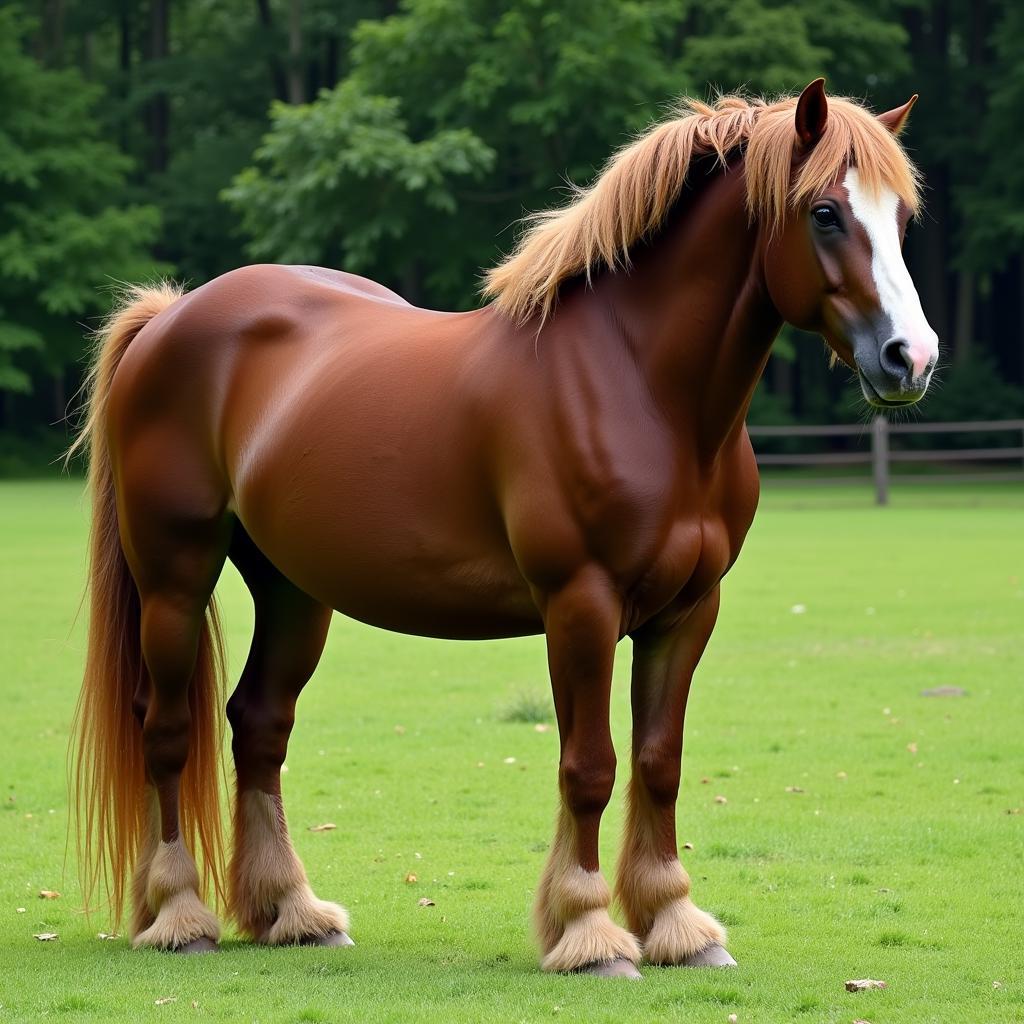Cold Blood Horses, known for their calm temperaments and impressive strength, have played a vital role in human history for centuries. These gentle giants are easily recognized by their substantial build, powerful legs, and a generally more relaxed demeanor than their hot-blooded counterparts. From working the fields to competing in specialized disciplines, the cold blood horse has proven its worth time and again. Let’s delve into the world of these incredible animals.
What Defines a Cold Blood Horse?
Cold blood horses are not a specific breed, but rather a type characterized by their heavy build, calm temperament, and strength. This contrasts with hot bloods, known for speed and agility, and warm bloods, a combination of the two.  Cold Blood Horse Standing in a Field They’re often described as “gentle giants” due to their patient nature and willingness to work. Their origins trace back to heavier horses used for agricultural work and as warhorses, where strength and stamina were paramount.
Cold Blood Horse Standing in a Field They’re often described as “gentle giants” due to their patient nature and willingness to work. Their origins trace back to heavier horses used for agricultural work and as warhorses, where strength and stamina were paramount.
Popular Cold Blood Breeds
Many distinct breeds fall under the cold blood classification. Some of the most well-known include the Clydesdale, with their iconic feathered legs and impressive size; the Shire, often considered the tallest horse breed; the Belgian Draft, known for their massive muscular build; and the Percheron, a breed prized for its elegance and versatility. Each breed has unique characteristics, but they all share the common traits of strength, calm temperament, and a steady work ethic.
Caring for a Cold Blood Horse
Caring for a cold blood horse is similar to caring for other horses, but their size and predisposition to certain health issues require specific considerations.
Dietary Needs
Due to their size, cold bloods require a substantial amount of forage. Providing good quality hay is essential, supplemented with grains and concentrates as needed to meet their energy requirements. best flooring for horse stalls can help keep their stall clean and comfortable. Overfeeding can lead to obesity and related health problems, so careful monitoring of their weight and diet is crucial.
Exercise and Training
While not known for speed, cold blood horses still need regular exercise to maintain their health and fitness. This can include light riding, groundwork, or simply turning them out in a pasture to graze and move around freely. sound horse ice boots are a great way to help cool down their legs after exercise, especially for heavier breeds. Their calm and willing nature makes them relatively easy to train, excelling in disciplines such as driving, logging, and other heavy work.
Health Concerns
Cold blood horses are prone to certain health issues, such as lymphedema, which can cause swelling in the legs, and draft horse COPD, a respiratory condition. Regular veterinary check-ups and proper hoof care are vital to maintaining their overall health. signs of hock problems in horses are important to recognize early to prevent further complications, especially in heavier breeds. Regular grooming is also essential, not only for their appearance but also to detect any skin issues or injuries early on.
“Maintaining a regular grooming routine is essential for cold bloods. It allows you to spot any potential health concerns early and helps build a strong bond with your horse,” says Dr. Emily Carter, equine veterinarian with over 20 years of experience working with draft breeds.
Cold Weather Care
While their name might suggest otherwise, cold blood horses are generally well-suited to cold weather due to their thick coats. However, providing adequate shelter from wind and rain is still essential, along with ensuring they have access to unfrozen water. horse cooling strategies are still relevant in warmer months, as these larger horses can overheat more easily. coat defence for horses can help protect their skin and coat from the elements, year-round.
The Future of Cold Blood Horses
Though their traditional roles in agriculture have diminished, cold blood horses continue to thrive in various disciplines, from recreational riding to competitive driving. Their gentle nature also makes them popular therapy animals. “The versatility and gentle disposition of cold blood horses ensure their continued relevance in the equestrian world,” shares John Miller, a renowned horse trainer specializing in draft breeds.  Cold Blood Horse Competing
Cold Blood Horse Competing
Conclusion
The cold blood horse, with its impressive strength, gentle nature, and rich history, continues to captivate horse lovers worldwide. Understanding their unique needs and characteristics is essential for providing them with the best possible care. From the majestic Clydesdale to the powerful Belgian Draft, these gentle giants hold a special place in the equine world.
FAQ
- What is the average lifespan of a cold blood horse? (25-30 years)
- Are cold blood horses good for beginners? (Yes, their calm temperament often makes them suitable.)
- How much do cold blood horses eat? (Considerably more than lighter breeds, often 2-3% of their body weight in forage daily.)
- What disciplines are cold blood horses suitable for? (Driving, logging, recreational riding, and therapy work.)
- Do cold blood horses need special shoes? (Yes, due to their weight and hoof size.)
- Are cold blood horses expensive to keep? (Their larger size often means higher costs for feed, bedding, and veterinary care.)
- Can cold blood horses jump? (While capable of small jumps, they are not built for high-level jumping.)
Need help with your horses? Contact us! Phone: 0772127271, Email: [email protected] or visit us at QGM2+WX2, Vị Trung, Vị Thuỷ, Hậu Giang, Việt Nam. We have a 24/7 customer service team.